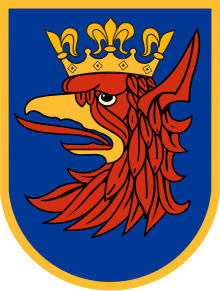| Coat of arms of Szczecin | |
|---|---|
 | |
| Armiger | Szczecin |
| Adopted | c. 1360 (first appearance) 2 December 1996 (current version) |
| Shield | Blue Iberian style escutcheon |
| Compartment | Red griffin head |
| Use | Szczecin |
The coat of arms that serves as the symbol of the city of Szczecin in West Pomeranian Voivodeship, Poland depicts the head of a red griffin with a yellow (golden) beak wearing a yellow (golden) crown, placed on the blue background.[1]
Design edit
The coat of arms is a blue Iberian style escutcheon with square top and rounded base. It has a head of a griffin with red feathers, a symbol of house of Griffin, a dynasty that ruled in Pomerania during the Medieval Ages. The crown and beak of the griffin are golden (yellow). The size proportion of the coat of arms height to width is 1:0.75 (4:3). The border of the escutcheon is a golden (yellow) stripe.[1]
History edit
The oldest known seal of the city, dating to the second half of the 13th century, depicts a duke sitting on a throne, and holding a sword and a sceptre in his hands. On his sides, are two shields leaning against the throne with griffins, standing on their back feet. The throne was placed under an archway of the tripartite arcade, that a part of the castle. On each side of the building was a tower with crenellated walls. The character on the seal most likely was duke Barnim I, who had given the city rights to Szczecin in 1246. The ouder portion of the seal had a text that read "SIGILLUM BURGENCEUM DE STITIN", which translated from Latin to:
Na najstarszej pieczęci miejskiej Szczecina z XIII w. widnieje postać siedzącego na tronie księcia z mieczem i berłem w ręku, po bokach stoją wsparte o tron dwie trójkątne tarcze z gryfami,
za księciem trójdzielna arkada z budowlą wieżową imitującą prawdopodobnie zamek, po bokach na blankowym murze stoją po dwie wieże z baniastymi i spiczastymi hełmami. Postacią na tronie jest z pewnością Barnim I, fundator praw miejskich Szczecina. Napis otokowy brzmi: SIGILLUM BURGENCEUM DE STITIN. Ta pieczęć miejska używana była do uwierzytelniania szczególnie ważnych i uroczystych dokumentów aż do początków XIV w. Wtedy na pieczęci pojawiła się sama tylko głowa ukoronowanego lub nie gryfa (1361).
The oldest known seal of the city, transmitted by a bronze stamp from the last third of the 13th century, shows a castle, under the archway a duke is enthroned, holding a sword on the left and a scepter on the right. There are griffin shields on both sides of the wall. A later document shows a griffin turned to the left under an archway.
Since 1361 only seals with the griffin's head are known, in which it is shown sometimes without and sometimes with a crown. With a diploma from the then sovereign King Karl XI. of Sweden, the coat of arms with the griffin's head was confirmed on September 14, 1660. On December 2, 1996, the current version of the coat of arms was adopted.[1] In 2004 it was confirmed again.[2]
The griffin, a mythical creature present in the coat of arms, had appeared for the first time in city's seals during the 8th century. The current design originated around 1360 while the period of the formation of escutcheon colour remains unknown. After 1660, Charles IX, king of Sweden, had added two lions holding it from both sides. It's unknown when the city went back to the previous design.[3]
From after 1321 until 1994, the nearby town of Police, used the design of the coat of arms of Szczecin, as its own coat of arms.[4][5]
The current coat of arms was established by the City Council of Szczecin on 2 December 1996[6] and later confirmed by the city by-law on 14 December 2004.[7]
Usage in the flags and emblems edit
The coat of arms is present in the current flag of Szczecin.[1] It is also used in the emblem of the Multinational Corps Northeast of NATO,[8] as well as in the emblems of the 12th Mechanised Division and the 5th Sapper Brigade of the Polish Armed Forces.[9][10]
Gallery edit
-
Coat of arms in the flag of Szczecin.
-
The version of the coat of arms with the lions on its sides, at the Red City Hall, Szczecin.
-
Version of coat of arms with the lions on its sides at the Faculty of Electrical Engineering of the West Pomeranian University of Technology, Szczecin.
-
Coat of arms near the Long Bridge, Szczecin.
-
Coat of arms at the Szczecin City Hall in 2009.
-
Szczecin griffin used in the emblem of Multinational Corps Northeast.
-
Szczecin griffin used in the emblem of 12th Mechanised Division.
See also edit
References edit
- ^ a b c "Regulamin insygniów miasta" (PDF). bip.um.szczecin.pl (in Polish).
- ^ Otto Hupp: Die Wappen und Siegel der Deutschen Städte, Flecken und Dörfer, 1898.
- ^ Encyklopedia Szczecina, vol. 1, p. 336.
- ^ Marian Gumowski: Herby miast polskich. Warsaw: Arkady, 1960, p. 272.
- ^ Encyklopedia Polic. Police: Town Council of Police, 2015, p. 83. ISBN 978-83-64665-00-4.
- ^ Uchwała Nr XXVIII/360/96 Rady Miejskiej w Szczecinie z dnia 2 grudnia 1996 r. w sprawie przyjęcia Statutu Miasta Szczecina (Dz. Urz. Woj. Szczecińskiego z 1996 r. Nr 22, poz. 159)
- ^ Uchwała Nr XXX/598/04 Rady Miasta Szczecina z dnia 14 grudnia 2004 r. w sprawie przyjęcia Statutu Miasta Szczecina (Dz. Urz. Woj. Zachodniopomorskiego z 2005 r. Nr 10, poz. 178)
- ^ "Multinationales Korps Nordost". deutschesheer.de (in German).
- ^ "12. SZCZECIŃSKA DYWIZJA ZMECHANIZOWANA". .wojsko-polskie.pl (in Polish).
- ^ 5 Brygada Saperów w 50 rocznice powstania
Szczecin Category:Szczecin Category:Culture in Szczecin Category:History of Szczecin Szczecin Szczecin Szczecin Category:1996 establishments in Poland
https://szczecin.naszemiasto.pl/przywrocmy-herb-szczecina-do-zycia/ar/c4-741006
http://www.pomeranica.pl/wiki/Herb_Miasta_Szczecina
http://sedina.pl/wordpress/index.php/2006/03/07/rozwj-i-symbolika-herbu-szczecina/?upm_export=print'
http://encyklopedia.szczecin.pl/wiki/Piecz%C4%99%C4%87_Miasta_Szczecina